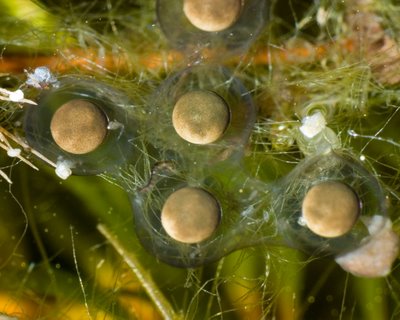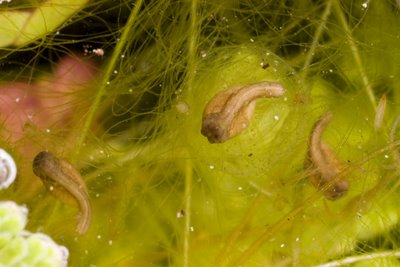
| A few nights ago the Perons Treefrogs (Litoria peronii) in my garden spawned for the first time this season. Two years ago when they spawned I took a few photos of the developing eggs in their early stages, and a few minutes ago I took a few more shots of a later developmental stage. What the early shots in particular show is to me quite amazing.
So it all begins one warm night when a female decides on the man she wants and they embrace in amplexus. She deposits the eggs singly or in small clumps and he immediately fertilises them.
|
I check the pond at 7:45 in the morning and find this. The eggs are only at the 4-cell stage labelled Stage 4 (modified Gosner stage from Anstis 2002). That means there have only been two cell divisions. Now that is cool.
| 
|

|
An hour later, 8:35, and another cell division has occurred. The eggs are now at stage 5 and consist of eight cells. You can clearly see the division between the animal (top) and vegetal (bottom) poles.
|
It's 9:20 now, and stage 6 (16 cell)
| 
|

|
10:30 and the cells are getting smaller and smaller (stage 7-8ish)
|
The cells are scarcely distinguishable from each other at midday
| 
|

|
The surface is now almost entirely smooth at 4:45 in the afternoon, after stage 9. Next stop, gastrulation! But I don't have photos of it. So there's a big gap between now and the next photo.
|
So this is the stage of the little guys in the tubs outside now as I type (stage 19ish). They're already capable of doing a bit of wriggling within the egg, and will hatch over the next few days. Interestingly, there's often what appears to be a bit of staggered development. So some of the embryos are more advanced than these ones, and will probably hatch sooner. Some stay in the capsules for ages.
| 
|
Reference: Anstis, M. 2002. Tadpoles of South-eastern Australia: A guide with keys. Reed New Holland (Australia).











6 comments:
Hmmm. You didn't give the time interval between the last two shots!
As I said, different set of years (the early photos are just under two years old, so that's the interval there (-:)
Can't really say how long the gap takes. My guess is about 24-48 hours.
Bonza! I'm looking forward to the next sequence.
David, would it be OK if I used your photos in lesson for my biology classes (high school)? I'm a public school teacher.
I think the photos are amazing and the kids would really get a kick out of seeing them.
No worries Vandalhooch, hope the kids are as amazed to see the process as I was.
Wow. Great photos. A classic.
Post a Comment